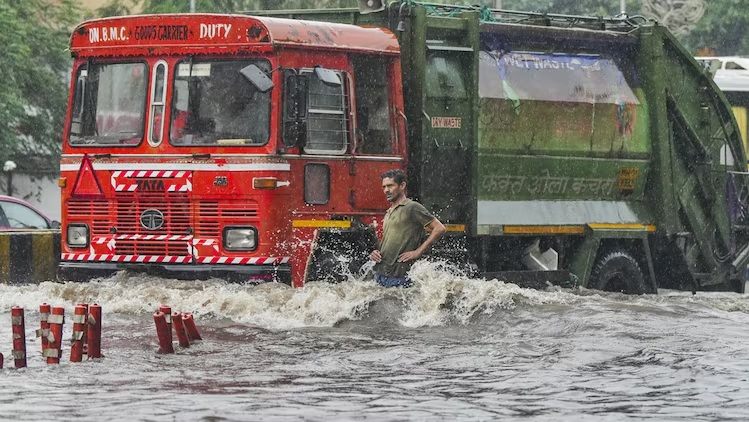Early monsoon shocks India: Is it a result of climate change or another factor?
News Mania Desk / Piyal Chatterjee / 27th May 2025

In 2025, the southwest monsoon entered India unusually early, reaching Kerala, Tamil Nadu, and extensive regions of Karnataka and Maharashtra several days before the expected date. On Monday, the monsoon arrived in significant cities such as Mumbai and Bengaluru—more than a week ahead of the anticipated date.
Two notable developments emerge: firstly, the monsoon’s premature onset by one to two weeks in different areas; secondly, its broad reach from Kerala to Maharashtra in just one day—May 24. An early start along with extensive coverage of the monsoon on the first day is not unheard of in India’s climatic history—but it is uncommon.
A similar event last took place in 1971, when the monsoon covered a significant area of Karnataka and parts of Maharashtra simultaneously, indicating heavy early rains.
While not the initial instance of its type, it has required more than fifty years to observe a comparable trend once more. Present predictions indicate that the active monsoon conditions are expected to continue until at least June 2. This prolonged period is anticipated to assist the monsoon’s advancement into Maharashtra and eastern India. Nonetheless, following this first spike, a deceleration in its progression is anticipated in early June—a typical event in recent years.
These short interruptions are frequently triggered by dry air incursions from mid-latitudes, which hinder the moisture-laden monsoon winds, leading to rainfall gaps and slowed advancement. These disruptions have grown more common, adding to the variability of the monsoon.
HOW CLIMATE CHANGE COULD HAVE AFFECTED THE EARLY OCCURRENCE
The arrival and progression of the monsoon are influenced by more than just a handful of isolated elements. Natural climatic systems and human-driven (anthropogenic) alterations—such as global warming and climate change—contribute to the situation.
Although the Indian Meteorological Department (IMD) asserts that global warming has a minimal impact on a vast system such as the monsoon, some emerging global trends indicate the contrary.
Decreased Snow Cover in Eurasia and the Himalayas: Global warming has resulted in a decline in snow cover throughout Eurasia and the Himalayas. From January to March this year, snow coverage was 15% lower than the average from 1990 to 2020. Reduced snowfall results in diminished surface albedo (reflectivity), leading to increased heating of the land surface—one factor contributing to enhanced monsoon circulation by mid-May.
Increased Atmospheric Humidity: For each degree Celsius of global warming, atmospheric moisture rises by 6–8%. With global temperatures in 2025 reaching approximately 1.2C higher than pre-industrial averages, this year experienced elevated moisture levels in the Arabian Sea and Bay of Bengal by May—encouraging early cloud development. Cyclonic events, such as the recent depression near the Karnataka-Goa coast, enhanced this impact even more.
Intensification of the Somali Jet and Cross-Equatorial Flow: The Somali Jet, an important low-altitude wind current starting close to Mauritius and Madagascar, strengthened in May 2025. This jet carries moisture-rich air over the Arabian Sea to the west coast of India, affecting Kerala, Karnataka, Goa, and Maharashtra. Its remarkable strength this year seems to have human-related influences.
CLIMATIC ELEMENTS INFLUENCING THIS YEAR’S EARLY MONSOON
The variability of the Indian monsoon is influenced by intricate interactions among atmospheric, oceanic, and terrestrial systems. A number of significant climate factors played a role in this year’s early arrival and swift progression:
Beneficial Madden-Julian Oscillation (MJO) Phase: The MJO is a tropical disturbance that travels eastward over a 30–60 day period, affecting the active (wet) and break (dry) phases of the monsoon. In mid-May, the MJO was in Phase 3, promoting convection and rainfall across southern India. By May 25, it moved into Phase 4—enhancing moisture flow from the Indian Ocean. These stages established perfect circumstances for the monsoon’s broad initiation.
Neutral El Nino Conditions: El Nino generally diminishes the southwest monsoon by increasing sea surface temperatures (SSTs) in the Pacific. This year, the El Nio–Southern Oscillation (ENSO) is in a neutral phase, eliminating a significant barrier to a robust monsoon season.
Impact of Indian Ocean Dipole (IOD): The IOD is characterized by the temperature difference between the western and eastern Indian Ocean. A favorable IOD boosts monsoon winds by improving the moisture flow from west to east. While the IOD is presently neutral, forecasts indicate a minor positive phase might emerge in August and September, possibly benefiting the second half of the monsoon.
Although the early and extensive arrival of the monsoon raises optimism for a fruitful rainfall period—essential for agriculture, water supply, and energy production—it also presents difficulties.
Quickly advancing monsoon conditions can result in severe rainfall occurrences, flooding, and disturbances in regions not ready for early precipitation. As India faces the increasing consequences of climate change, it is more essential than ever to comprehend the changing patterns of the monsoon. The 2025 season has already shown to be exceptional, and its progression in the next weeks will provide greater understanding of the new normal in South Asia’s climate trends.






